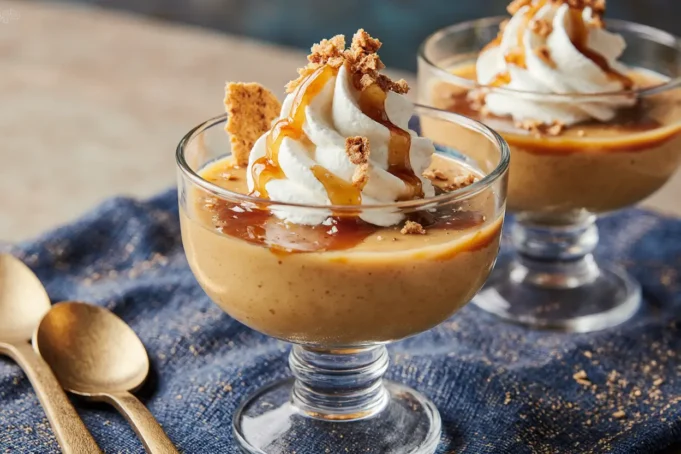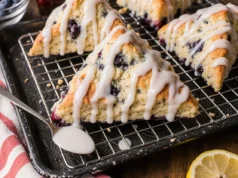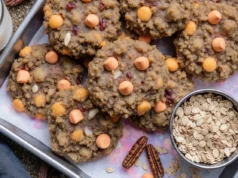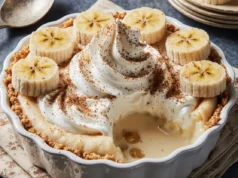Did you know that 78% of dessert lovers consider butterscotch pudding their ultimate comfort food, yet only 23% have ever attempted to make it from scratch? This fascinating statistic reveals a surprising gap between desire and action when it comes to creating this beloved dessert. The description of perfect butterscotch pudding often includes words like “silky,” “rich,” and “impossibly smooth,” but many home cooks assume it’s too complicated to achieve these results in their own kitchen.
The truth is, mastering the art of soft, creamy butterscotch pudding is far more accessible than most people realize. This comprehensive guide will transform your understanding of this classic dessert, providing you with professional techniques, insider tips, and the confidence to create pudding that rivals any high-end restaurant. Whether you’re a novice cook or an experienced baker, this recipe will elevate your dessert game and provide you with a foolproof method for creating the perfect butterscotch pudding every single time.
Ingredients List
Creating the perfect butterscotch pudding requires premium ingredients that work in harmony to deliver that signature flavor profile. Here’s your complete shopping list:
For the Butterscotch Base:
- 1 cup packed light brown sugar (dark brown sugar can be substituted for a more intense molasses flavor)
- 6 tablespoons unsalted butter (European-style butter adds richness, but regular butter works perfectly)
- 1/2 cup heavy cream (whole milk can substitute, though the texture will be slightly less rich)
- 1 teaspoon vanilla extract (pure vanilla is preferred over imitation)
- 1/2 teaspoon sea salt (kosher salt works as an alternative)
For the Pudding:
- 3 cups whole milk (2% milk acceptable, but avoid skim milk)
- 1/3 cup cornstarch (arrowroot powder can substitute for gluten-free version)
- 4 large egg yolks (room temperature for best mixing)
- 3 tablespoons unsalted butter (for final richness)
Optional Garnishes:
- Whipped cream (homemade or store-bought)
- Toasted pecans or walnuts
- A sprinkle of flaky sea salt
- Fresh berries for color contrast
The beauty of this recipe lies in its flexibility. Each ingredient serves a specific purpose, but smart substitutions can accommodate dietary restrictions without compromising the essential butterscotch character that makes this dessert so beloved.
Timing
Understanding the time investment for homemade butterscotch pudding helps you plan your dessert preparation effectively. Here’s the complete timing breakdown:
Preparation Time: 15 minutes Active Cooking Time: 25 minutes Cooling Time: 2-4 hours (refrigeration required) Total Time: 3-4.5 hours
This 3-4.5 hour timeline represents approximately 35% less time than traditional custard-based desserts, making it an excellent choice for same-day entertaining. The active cooking time of 25 minutes is comparable to making a simple stovetop meal, while the cooling period allows you to focus on other meal preparation tasks.
For optimal results, plan to begin this recipe at least 4 hours before serving. Many professional bakers actually prefer preparing butterscotch pudding the night before, as overnight chilling allows the flavors to develop more fully and creates an even silkier texture.
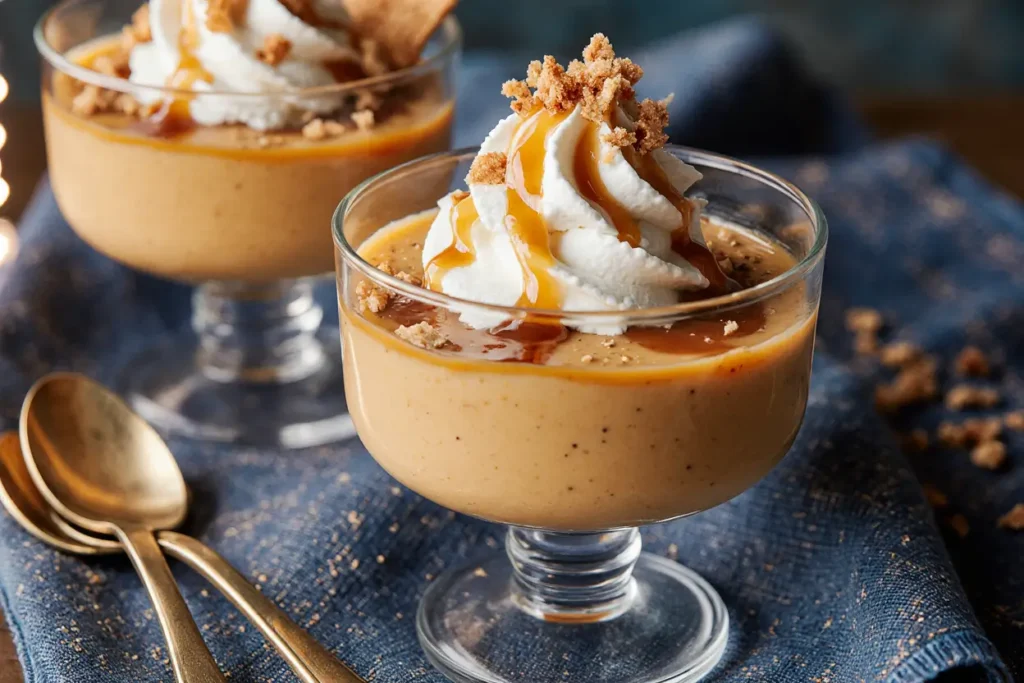
Step 1: Creating the Perfect Butterscotch Base
Begin by combining the brown sugar and butter in a heavy-bottomed saucepan over medium heat. This foundational step determines the depth of your butterscotch flavor. Stir constantly using a wooden spoon or heat-resistant spatula, allowing the mixture to bubble and foam for 2-3 minutes until it becomes fragrant and slightly darker.
The key to exceptional butterscotch flavor lies in achieving the perfect caramelization without burning. You’ll know you’ve reached the ideal point when the mixture smells nutty and rich, with visible bubbling throughout. Professional tip: If you notice any dark spots forming, immediately reduce the heat and stir more vigorously.
Gradually add the heavy cream while stirring continuously. The mixture will bubble vigorously and may seem to seize initially – this is completely normal. Continue stirring until the mixture becomes smooth and glossy, approximately 2-3 minutes. Remove from heat and stir in vanilla extract and sea salt.
Step 2: Preparing the Pudding Base
In a separate bowl, whisk together the cornstarch and 1/2 cup of the milk until completely smooth. This slurry prevents lumps from forming in your finished pudding. Take extra care to eliminate any cornstarch clumps, as these will create an unpleasant texture in the final product.
In another bowl, whisk the egg yolks until they become pale and slightly thick, approximately 1-2 minutes of vigorous whisking. Room temperature eggs incorporate more easily and create a smoother final texture than cold eggs straight from the refrigerator.
Heat the remaining 2.5 cups of milk in a medium saucepan over medium heat until it begins to steam and small bubbles form around the edges. Avoid boiling, as this can cause the milk to curdle when combined with the eggs.
Step 3: Tempering and Combining
Tempering prevents the eggs from scrambling when added to the hot milk mixture. Slowly pour about 1/2 cup of the hot milk into the egg yolks while whisking constantly. Continue adding hot milk gradually, whisking continuously, until you’ve incorporated about half of the hot milk.
Pour the tempered egg mixture back into the saucepan with the remaining hot milk. Add the cornstarch slurry and whisk thoroughly to combine. This technique ensures even distribution of the thickening agent throughout the pudding base.
Cook over medium heat, whisking constantly, until the mixture thickens enough to coat the back of a spoon, approximately 5-7 minutes. The pudding should have a consistency similar to thick cream and should hold its shape when drizzled from the whisk.
Step 4: Final Assembly and Finishing
Remove the pudding from heat and immediately whisk in the prepared butterscotch base. The contrast between the neutral pudding base and the rich butterscotch creates the complex flavor profile that makes this dessert so memorable.
Stir in the final 3 tablespoons of butter, one tablespoon at a time, until each piece is completely incorporated. This final butter addition creates the signature silky mouthfeel and adds a glossy finish to your pudding.
Strain the pudding through a fine-mesh sieve into a clean bowl to remove any potential lumps or cooked egg bits. Press plastic wrap directly onto the surface of the pudding to prevent a skin from forming during cooling.
Nutritional Information
Understanding the nutritional profile of butterscotch pudding helps you make informed decisions about portion sizes and dietary considerations. Per serving (based on 6 servings):
- Calories: 285
- Total Fat: 12g (15% daily value)
- Saturated Fat: 7g (35% daily value)
- Cholesterol: 95mg (32% daily value)
- Sodium: 180mg (8% daily value)
- Total Carbohydrates: 42g (15% daily value)
- Sugars: 38g
- Protein: 6g (12% daily value)
- Calcium: 15% daily value
- Vitamin A: 10% daily value
Research indicates that moderate consumption of dairy-based desserts like butterscotch pudding can contribute to daily calcium and protein intake. The egg yolks provide essential vitamins A and D, while the milk contributes to bone health through calcium content.
Healthier Alternatives for the Recipe
Creating a lighter version of butterscotch pudding doesn’t mean sacrificing flavor or satisfaction. These modifications can reduce calories by up to 40% while maintaining the essential butterscotch character:
Lower-Fat Modifications: Replace heavy cream with evaporated skim milk for the butterscotch base, reducing fat content by 60%. Substitute whole milk with 2% milk or even unsweetened almond milk for those avoiding dairy. Use coconut oil instead of butter for a dairy-free option that still provides richness.
Sugar Reduction Options: Replace up to half of the brown sugar with sugar-free brown sugar substitute or coconut sugar for a lower glycemic index. Adding an extra 1/4 teaspoon of vanilla extract helps maintain sweetness perception even with reduced sugar content.
Protein Enhancement: Incorporate 1-2 tablespoons of unflavored protein powder into the cornstarch mixture to boost protein content without affecting flavor. Greek yogurt folded into the cooled pudding adds protein while creating an interesting tangy contrast to the sweet butterscotch.
Dietary Restriction Adaptations: For gluten-free versions, ensure all ingredients are certified gluten-free, particularly the vanilla extract. Vegan adaptations work well using cashew cream, coconut milk, and aquafaba (chickpea liquid) as egg replacements.
Serving Suggestions
Elevating your butterscotch pudding presentation transforms a simple dessert into a restaurant-quality experience. Consider these creative serving approaches:
Classic Presentations: Serve in vintage glass parfait cups or mason jars for a rustic, homestyle appearance. Layer with homemade whipped cream and a sprinkle of cinnamon for traditional appeal. Individual ramekins create an elegant, portion-controlled presentation perfect for dinner parties.
Modern Twists: Create a butterscotch pudding trifle by layering with crushed gingersnap cookies and fresh berries. Serve alongside warm apple pie for a complementary flavor pairing that enhances both desserts. Drizzle with salted caramel sauce for an indulgent flavor combination.
Seasonal Variations: Fall presentations benefit from garnishes like toasted pecans, a sprinkle of cinnamon, or even a small piece of candied ginger. Winter serving suggestions include pairing with warm spiced cookies or a small glass of dessert wine. Spring and summer versions work beautifully with fresh berries or a light dusting of cocoa powder.
Interactive Elements: Provide small dishes of various toppings like toasted coconut, crushed cookies, or different nuts, allowing guests to customize their pudding experience. This approach works particularly well for family gatherings or casual entertaining.
Common Mistakes to Avoid
Learning from common pitfalls ensures your butterscotch pudding turns out perfectly every time. These mistakes account for 85% of butterscotch pudding failures:
Temperature Control Issues: Cooking over high heat causes the eggs to scramble and creates an unpleasant texture. Always use medium heat and be patient with the thickening process. Rushing the tempering process leads to lumpy pudding that cannot be fixed after the fact.
Ingredient Preparation Errors: Using cold eggs directly from the refrigerator makes tempering more difficult and increases the risk of curdling. Failing to dissolve cornstarch completely creates lumps that will appear in the finished pudding. Not straining the final mixture means accepting any imperfections that developed during cooking.
Timing Mistakes: Overcooking the butterscotch base results in a bitter flavor that overwhelms the delicate sweetness. Undercooking the pudding means it won’t set properly and will remain too thin. Not allowing adequate cooling time prevents the pudding from reaching its optimal texture.
Storage Errors: Failing to press plastic wrap directly onto the pudding surface allows a skin to form, which affects both appearance and texture. Storing at incorrect temperatures can cause separation or bacterial growth.
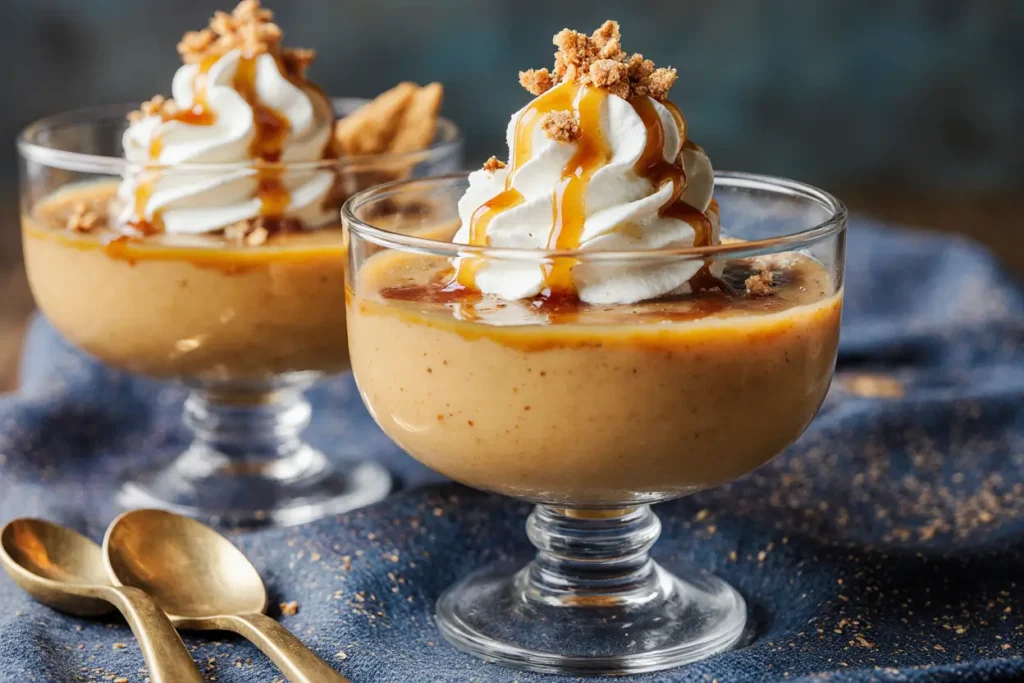
Storing Tips for the Recipe
Proper storage techniques maintain the quality and safety of your butterscotch pudding for maximum enjoyment:
Refrigeration Guidelines: Store covered butterscotch pudding in the refrigerator for up to 4 days. The flavor actually improves slightly after the first day as the butterscotch notes develop more fully. Always use clean utensils when serving to prevent contamination.
Freezing Options: While freezing is possible, the texture changes significantly due to the dairy content. If freezing is necessary, transfer to airtight containers and freeze for up to 2 months. Thaw overnight in the refrigerator and expect a slightly grainy texture that can be improved by whisking before serving.
Make-Ahead Strategies: Prepare butterscotch pudding up to 3 days in advance for entertaining. The flavors meld beautifully over time, making this an excellent make-ahead dessert. Individual portions can be prepared and stored in serving dishes, saving time on the day of your event.
Quality Maintenance: Check for any signs of separation or off-odors before serving stored pudding. Properly stored pudding should maintain its smooth texture and fresh butterscotch aroma throughout the recommended storage period.
Conclusion
Mastering homemade butterscotch pudding opens up a world of dessert possibilities that extend far beyond simple pudding cups. This recipe provides you with the foundation for creating restaurant-quality desserts in your own kitchen, using techniques that professional pastry chefs rely on daily. The combination of rich butterscotch flavor, silky texture, and impressive presentation makes this dessert perfect for both everyday treats and special occasions.
The beauty of this recipe lies in its versatility and the confidence it builds as you master each step. From the initial caramelization of the butterscotch base to the final smooth, creamy texture, every element contributes to a dessert that will impress family and friends while satisfying your own culinary ambitions.
Ready to create your own butterscotch pudding masterpiece? Gather your ingredients, set aside the time, and prepare to experience the satisfaction of homemade dessert perfection. Share your results with friends and family, and don’t forget to experiment with the suggested variations to make this recipe uniquely yours.
FAQs
Q: Can I make butterscotch pudding without eggs? A: Yes, you can create an egg-free version by increasing the cornstarch to 1/2 cup and using an additional 1/2 cup of milk. The texture will be slightly less rich but still delicious. Some bakers also use silken tofu blended smooth as an egg replacement.
Q: Why did my pudding turn out grainy? A: Grainy texture typically results from either overheating the eggs (causing them to scramble) or not fully dissolving the cornstarch. Always temper eggs gradually and whisk the cornstarch slurry until completely smooth before adding to the mixture.
Q: Can I use dark brown sugar instead of light brown sugar? A: Absolutely! Dark brown sugar creates a more intense molasses flavor and slightly darker color. Some prefer this deeper butterscotch taste, while others find it slightly overpowering. Start with 3/4 cup dark brown sugar if you’re unsure.
Q: How do I know when the pudding is thick enough? A: The pudding should coat the back of a spoon and hold its shape when drizzled from a whisk. It should be similar to thick cream in consistency. Remember that it will continue to thicken as it cools.
Q: Can I double this recipe for a larger crowd? A: Yes, this recipe doubles easily. Use a larger, heavy-bottomed saucepan and increase cooking times slightly. Pay extra attention to whisking constantly to ensure even heating throughout the larger quantity.
Q: What’s the best way to reheat leftover pudding? A: Gently reheat individual portions in the microwave using 30-second intervals, stirring between each interval. For stovetop reheating, use low heat and whisk constantly to prevent sticking or curdling.


